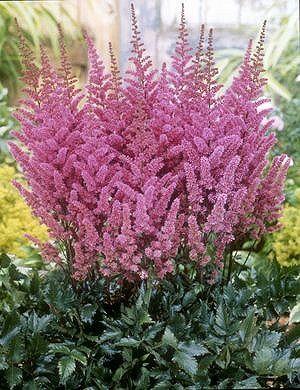
|
|
Astilbe
- (Astilbe chinensis thunbergii)
|
Astilbe - False Goat's Beard (Astilbe spp.)
Astilbe is a genus of 18 species perennial, herbaceous flowering plants, within the family
Saxifragaceae. Some species are commonly known as False Goat's Beard, and False
Spirea. Astilbe species are native
in East Asia (Japan, Korea and China) and North America.
They are cultivated by gardeners as hardy herbaceous perennials, for their large
handsome, often fern-like foliage, and dense, feathery plumes or arching spires of
flowers, which come in shades of pink, red, crimson, purple and white. These plants form clumps and grow from 6 inches to
5 feet high. They require a peaty soil for their successful cultivation. Numerous hybrids have been
raised.
Astilbe also known as False Goat's Beard. Blooms in May to July, feathery plumes about 2 feet
tall. Good in shade or sun. Showy panicles or plumes of feathery flowers that are the hallmark of
astilbe. The first species known to European growers was Bergenia crassifoilia, a Siberian variety first seen in 1760 that had large red flowers on sturdy
stems. Modern cultivars come from around the world, including alpine and arctic regions
alike, in shades varying from the palest pink to lavender, rose, crimson and
white. Common names for this graceful pyramid-shaped flower are false spirea and goat's
beard.
Research into the discovery of the plant leads us to the travels of Ernest Henry Wilson (1876-1930) who was a botanist associated with the University of
London. He was sent on a mission to China to trace the incredible Dove tree - Davidia
Involucrata. From there, he collected seeds of many plants including the seeds of Astilbe
davidii. This explains the advent of this variety into the West.
Astilbes are easy to locate in any garden that boasts growing them. They range in height starting from 6 inch miniatures to 5 feet tall
plants. These plants can be grown to give background cover as tall plants or in
beds, borders, and as expanses of ground cover.
If you cut the plumes before they are completely
open, they last very well as a cut flower. The plumes can also be used for
drying.
Some species of Astillbe are
edible. The
young leaves of Astilbe thunbergii are edible cooked and the leaves of Astilbe
longicarpa are a tea substitute
The fruiting parts are eaten fresh.
The dried rhizomes of Astilbe thunbergii have been traditionally used for the treatments of a sword
cut, wound bitten by animals, frost-bite, burn, suppurative dermatitis or skin inflammatory diseases from the Tang period
(about 8th century) in China.
Source:
http://en.wikipedia.org/wiki/Astilbe
http://www.mywebgarden.com/articles/flower_types/
astilbe_description.html
http://www.pfaf.org/database/plants.php?Astilbe
http://lib.bioinfo.pl/auth:Sakanaka,M
